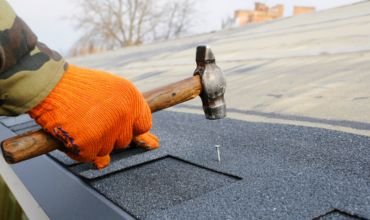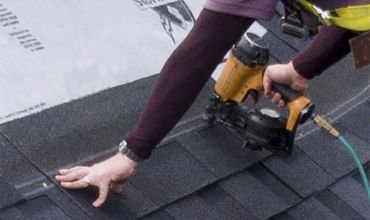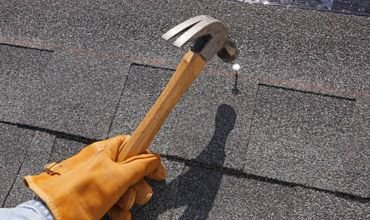Most homeowners spend a fortune on premium shingles so that their roofing project finally takes the shape they desire. However, in the process, one often gives little to no thought to the nails that must be used or avoided for a secured roof. Opting for the wrong nails–too short, rust-prone, or just plain flimsy can lift your beautiful shingles within a year. Thus, exposing your roof to severe water damage (infiltration) and weather destruction, in which each gust of wind will feel like a threat. To make sure that your shingle doesn’t come loose or begin to leak, you must have a clear-cut answer to the question, “What type of nails for a shingle roof?”
Choosing the right nails isn’t just about securing your shingles; it’s more about ensuring the safety of your entire structure. The right type of nails will firmly grip the shingles to the deck of the roof, withstanding harsh weather conditions and resisting corrosion.
Let ManageMyRoof take you on the right path, assisting you in avoiding the potential disaster in waiting.

A nail isn’t a nail–there’s more to it!
Just like there are different types of shingles available; so are the types of roofing nails available. The most common types of nails used to attach shingle roofs are as follows:
A ring shank also known as the “annular or corrugated roofing nail” is the first type you’ll find. As the name suggests, a ring shank can be seen with a ring-like structure on its body. These rings aren’t connected to one another but are there to be connected with screws. The ring shank is said to provide extra grip, staying power, and strength when used to attach the shingles and sheathing.
Some studies suggest that ring shanks (nails) have superior strength than smooth ones. This makes the ring shanks perfect for areas with high chances of heavy wind.
Another type of shingle roofing nail is Square Cap, specifically designed for easy and quick shingle installation. Not only these roofs are perfect for fastening the felt, but also work best with the house wrap, underlayment, sheathing, and more. If you have seen a square cap, you must know that there is a wide square-shaped head and not a circular one. The shank of these nails can either be smooth or coiled.
You must also have the knowledge that Square Cap may work perfectly with the felt underlayment, but if you try to install asphalt shingles with these, you might get yourself in trouble.
Last but not least, and the most common type of nail found on all construction sites is the Smooth Shank, which successfully punctures right throw the material you are trying to nail. In simple words, and as the name itself suggests, a Smooth Shank has a smooth shank. These are cheaper to purchase than the ring shank or a square cap. (Buy only if it fits the requirement).
These might be the least complex (groove-free and hammer-friendly) or the cheapest, but they aren’t as effective as the other two options. However, when one is looking forward to framing, finishing, or completing other tasks of carpentry, these will surely work the best.

All three types of nails; to remind: Ring, Square, and Smooth Shank are available in the following materials. Now the aspect one must consider when choosing the right nail material must be kept in the loop with how well it can hold a shingle down and the lifespan it arrives with. Let’s go through the available options.
First and foremost, you have the option to go with copper nails; rust-free and corrosion-resistant. These are perfect for copper flashing roofs and accessories. You must understand that copper nails might work with some roofs but should be completely outed from the other kinds. Copper usually appears to be dark brown or gold.
The second option we have is aluminium, which ultimately is weaker than steel or copper nails. Nevertheless, these are still used on asphalt shingle roofing by some of the roofers. You must know that aluminum is extremely prone to chemical, corrosion, and salt damage, unlike steel ones. If a simple roofing project is what you desire, it is good enough to use. However, if you live in counties or coastal towns, the material must be avoided.
One of the many advantages of using stainless steel nails over aluminum ones is that they are not corrosive or aren’t as corrosive as aluminum ones. For this very obvious reason, some of the best roofers prefer to use stainless steel nails. If salty air is the factor to be considered in your roofing project, these will work best for you. These are stronger, adhesive, but aren’t as good as the other option you are still left with.
Using galvanized steel nails is your best bet when deciding on the best nail material for your roofing project. Commonly known as “galvanized nails” or “hot dip galvanized roofing nails” these are made up of steel bases and are coated with zinc chemicals afterward. The coating of zinc creates that extra layer of protection from corrosion and rust, making it extra powerful. If it helps, this very material is better than aluminum or copper.

Now that you have information about the material and the types of nails available or that you must use to create that perfect roof structure of your house or commercial building, it’s time that you consider getting information or intel about the size as well. Here’s the gauge, length, and diameter, you must consider the following when purchasing nails:
As per the International Building Code (IBC), the head diameter of a roofing nail must be at least 9.5 mm. Just like the shank diameter, it is quite easy to find the nails with a larger head (can definitely be used) but avoid using the smaller ones.
If we take into account the considerations of the International Building Code (IBC) (2018 edition) that states “fasteners for asphalt shingles must be a minimum of a 12-gauge shank.” It’s evident that these will work best for your shingle roof. It is quite common to find nails with the said head diameter, as they comply with the IBC needs.
Are you the “Do-It-Yourself” kind of person? If so, knowing just the type of nail you must use or the material you should go with isn’t enough for successfully re-roofing your structure; you will need more.
If we take into consideration the GAF’s guidelines or regulations, one must secure his roof with at least 4 to 6 nails per shingle. Most shingle lines fit best with 6 nails.

If you follow the strategy of using 6 nails per shingle, you will require around 506 nails for entirely covering your roof. However, it also depends upon the size of your roof so don’t hold yourself to one number. Instead, get in touch with the roof installation service providers to understand the math better.
Each shingle bundle contains approximately 28 shingles, and one roofing square is about 100 square feet. One bundle of shingles can cover a one-third area of the roof square. On the basis of this, you can get a clear idea or at least an approximate of how many nails you will require.
When replacing your roof, selecting the right tool is crucial. You have two options: a nail gun or a hammer. While both can get the job done, consider the following factors before starting:
| Nail Gun | Faster installation (especially for asphalt shingles) Requires electro-galvanized roofing nails Higher upfront cost (rental or purchase) Ideal for large-scale projects |
| Hammer | Lower upfront cost More labor-intensive Requires 1.25’’ or 1.5’’ loose roofing nails Suitable for smaller projects or DIY enthusiasts |
| Nail Selection | Loose roofing nails (1.25’’ or 1.5’’) for hammer Electro-galvanized roofing nails for nail guns Available in 1-pound, 5-pound, or 30-pound boxes |
| Considerations | Asphalt shingles require at least 6 nails per shingle for warranty eligibility Nail gun rental or purchase costs vs. hammer costsProject scale and time constraints |
Choose your tool wisely to ensure efficiency, cost-effectiveness, and quality results for your roof replacement project. Following the proper techniques and using the right tools will surely help you in the long run.

That was everything one needed to know about the type of nails for a shingle roof. As mentioned, choosing the wrong nail can harm your roofing project, turning it into a disaster. And, it’s obvious that you won’t want to do that to your roof. However, if you are mindful enough and gather the information beforehand, you can avoid such mishaps. Getting in touch with a professional roofer or roofing service is always the best bet as they have the right knowledge and tools to set up your roof.
We hope that you were able to get the answers you needed. In addition, if you have any more queries or doubts, feel free to connect with us at ManageMyRoof. We’d be happy to comply with your needs.
No, one must not reuse the shingle roofing nails again even if you have tons of it, as it is tedious to yank the nails out. Plus, they will cause issues in your newly replaced roof.
Homeowners can use zinc-coated steel or aluminum nails with a gauge of 10-12 (deformed, barbed, or smooth shank roofing nails for a shingle roof.
No. Nails are preferred due to their ability to handle the expansion & contraction of shingles.
Hammer the nail back in or replace it with a new one. Seal the area with roofing cement.
Use galvanized or stainless steel nails for durability and corrosion resistance.
Roofing nails or galvanized nails are best for securing flashing.
Roofing nails or cap nails work well for securing felt or underlayment.
Typically, 1¼ to 2-inch roofing nails are used for shingles.
Stainless steel or galvanized nails are recommended for wood shingles.
Stainless steel or galvanized nails and staples are commonly used.
A single shingle will require at least 6 nails for proper attachment. Following the standard number of nails will ensure that you create a roof that is not easily impacted by wind or weather elements.
Leave a Reply